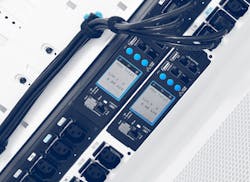How Intelligent Power Can Predict the Future
In a Q&A interview, Ashish Moondra, Director of Strategic Alliances & Electronics Product Management at Chatsworth Products (CPI), explains how combining intelligent power distribution units (PDUs), long-lasting uninterruptible power supply (UPS) battery back-up and powerful data center infrastructure management (DCIM) software into a single, integrated solution can minimize downtime, help forecast budgets and ensure the right personnel now and in the future.
Predictive power modeling is the utilization of power and environmental information available through intelligent power devices within the power chain. These devices can include intelligent rack-mounted PDUs, remote power panels (RPPs) and UPS to enhance the availability and efficiency of data centers, network rooms and edge compute sites. Predictive power modeling also helps with better capacity planning and optimal usage of space, power and cooling resources.
How can predictive power modeling mitigate and eliminate downtime in data centers?
The monitoring of power quality devices ensures that IT equipment always receives the appropriate voltage, frequency and wave forms needed to operate properly.
Additionally, monitoring UPS battery charge or generator fuel levels ensures that devices can reliably provide the ride-though times required to sustain uptime during most outages.
Power distribution devices at the cabinet, row or floor levels have branch overcurrent protection with finite capacities. Monitoring the amperage and power usage of these devices ensures that data center operators are notified of any impending issues. This allows for corrective actions to be taken prior to an actual downtime occurring.
Finally, environmental monitoring that’s integrated directly into intelligent PDUs ensures that literal, thermal hot spots are quickly detected at the cabinet level and corrected before they negatively impact the performance of IT equipment.
How can predictive power modeling help with planning and forecasting?
Trending historical consumption data and extrapolating that into the future with DCIM software solutions provides the ability to determine when extra capacity or new builds may be required to support growth within an organization.
In addition, reports that provide percentage loading of power resources down to granular levels allows visualization of areas where stranded capacity is available. This information not only helps data center operators maximize utilization of power, cooling and spatial assets, but also to defer capital expenditures.
What features are important to have in a predictive power modeling system?
All elements of a predictive power modeling system need to work as a part of a cohesive ecosystem. To achieve that kind of synergy, each individual element needs to be easily usable, manageable, integrable and highly secure.
Usability requires that the solution be capable of being easily configured en masse. It also requires that the solution provides a practical, approachable interface and be capable of being accessible and viewable with the most used web browsers.
Manageability requires that the solution be capable of providing snapshot status updates. It should also be able to set warning and critical thresholds and generate appropriate notifications and alerts when those thresholds are exceeded. The system also needs to include logging capabilities for effective troubleshooting and audit reasons.
Integrability requires that the hardware elements support the most common protocols, such as SNMP, APIs, CLI for all equipment and MODBUS / BACNet for grey space equipment. The equipment also needs to provide customers with the ability to use the mode of integration of their choice.
Security requires that the elements are all capable of supporting enterprise-level authentication and multiple permission levels. In addition, all data communication happening among the elements or externally needs to be encrypted. All elements need to be tested all the time against newly arising security vulnerabilities.
How does battery technology, specifically lithium iron phosphate batteries, impact UPS predictive modeling?
Irrespective of the battery technology being utilized, effective UPS predictive power modeling should be capable of providing the battery charge status and the runtime available in the event of an outage. For large, three-phase UPS deployed where preventive maintenance is a normal occurrence, information regarding the last service date for the batteries should also be readily available.
Lithium iron phosphate batteries for UPS applications always include a battery management system that protects the battery cells against higher temperatures and charging currents that could potentially degrade the performance of the battery. This, along with the overall longer life span and faster recharge time, make these a preferable battery solution that minimizes downtime and increases reliability.
Ashish Moondra is Director of Strategic Alliances & Electronics Product Management at Chatsworth Products. Contact CPI to learn more about how predictive power modeling can help your data center operations.



